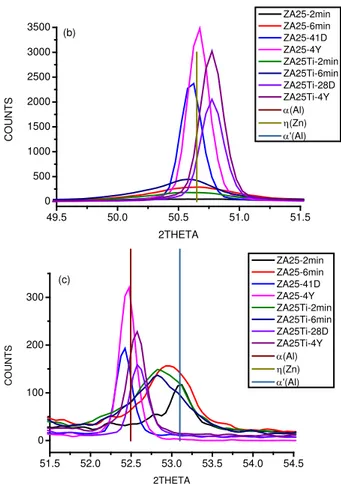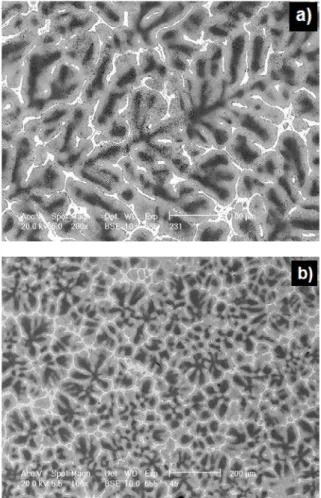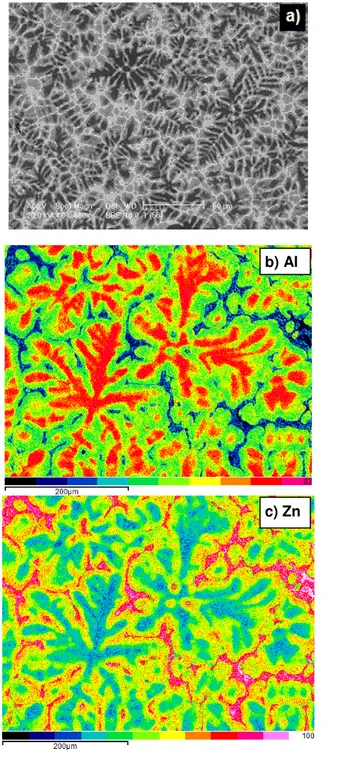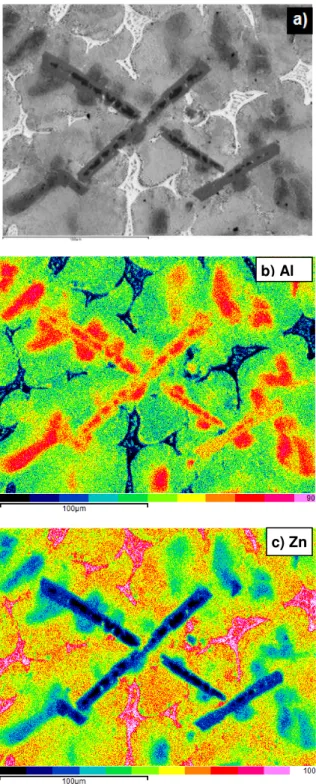A R C H I V E S
o f
F O U N D R Y E N G I N E E R I N G
Published quarterly as the organ of the Foundry Commission of the Polish Academy of Sciences
ISSN (1897-3310) Volume 12 Issue 1/2012
61 – 66
12/1
Structural stability of the high-aluminium
zinc alloys modified with Ti addition
W.K. Krajewski
a*, P.L. Zak
a, J. Orava
b, A.L. Greer
b, P.K. Krajewski
a aAGH University of Science and Technology, Faculty of Foundry Engineering, Reymonta 23 Str., 30-059 Krakow, Poland
b
University of Cambridge, Department of Materials Science and Metallurgy, Pembroke Str., 3QZ 2B2 Cambridge, UK
* Corresponding author. E-mail address: krajwit@agh.edu.
Received 01.02.2012; accepted in revised form 19.03.2012
Abstract
The subject of the paper is structural stability of the Zn-26 wt.% Al binary alloys doped with 2.2 wt.% Cu or 1.6 wt.% Ti addition. The structural stability of Zn-Al alloys with increased Al content is connected with stability of solid solution of zinc in aluminium α', which is the main component of these alloys microstructure. Such a solution undergoes phase transformations which are accompanied, among others, by changes in dimensions and strength properties.
The structural stability of the ZnAL26Cu2.2 and ZnAl26Ti1.6 alloys was investigated using XRD examinations during long term natural ageing after casting, as well as during long term natural ageing after super-saturation and quenching. On the basis of the performed examinations it was stated that small Ti addition to the binary ZnAl25 alloy, apart from structure refinement, accelerates decomposition of the primary α' phase giving stable structure in a shorter period of time in comparison with the alloy without Ti addition. Addition of Ti in amount of 1.6 wt.%, totally replacing Cu, allows obtaining stable structure and dimensions and allows avoiding structural instability caused by the metastable ε−CuZn4 phase present in the ZnAl26Cu2.2 alloy.
Keywords: High Aluminium Zinc alloys; Ti addition; Structural stability; XRD examinations
1. Introduction
Zinc based cast alloys have good mechanical and technological properties, therefore they are commonly used in industry. These alloys can be gravity cast into sand, semi-permanent and metal moulds, and their main application is in production of machines and parts of devices. Technology of casting of zinc alloys covers continuous, semi-continuous, centrifugal and investment casting as well as casting under pressure. In recent years, zinc-based alloys have been also used for semi-solid casting, e.g. squeeze casting [1-2]. Alloys based on Zn-Al with the increased amount of Al are generally stronger than
The phase transformations are connected with solid solution of zinc in aluminium α, which is the main component of these alloys microstructure. Such a solution undergoes phase-transformations which are accompanied by, among others, changes in dimensions, electrical resistance and strength properties.
Numerous papers on investigations of structural stability, phase transformations and their effect on the Zn-Al alloys properties include, among others, influence of Cu [4-5], RE [6-8] and Ti [9-12].
In paper [4] it was found that addition of Cu prolongs process of decomposition in the alloy Al-78wt%Zn-(1-3) wt.% Cu in room temperature to about half a year. It should be pointed out that the metastable ε-CuZn4 phase takes part in the so-called
four-phase reaction to form a stable T'-Al5Cu4Zn phase. However, the
four-phase reaction can lead to an increase of volume of the Zn-Al-Cu alloys even by 4.5 % [5].
In the papers [6-7] the effect of rare earth elements (RE) on the course of ageing of the alloy ZA-27 was investigated. It was determined that the addition of up to 0.3wt% of RE (mainly La, Ce and Nd ) does not influence the sequence of phase transformations observed in supersaturated alloy ZA27 without RE addition [8].
The effect of a small (0.04 wt%) Ti addition on the structural stability of high-aluminium zinc alloys was investigated in the papers [9-12]. The investigations were carried on the alloy Zn-25wt%Al, which is the base of the ZA27 alloy and its Polish analogue Z284.
49 50 51 52 53 54
0 500 1000 1500 2000 2500 3000 3500 CO UNT S 2THETA ZA25-2min ZA25-6min ZA25-41D ZA25-4Y ZA25Ti-2min ZA25Ti-6min ZA25Ti-28D ZA25Ti-4Y α(Al) η(Zn) α'(Al) (a)
49.5 50.0 50.5 51.0 51.5
0 500 1000 1500 2000 2500 3000 3500 CO UNT S 2THETA ZA25-2min ZA25-6min ZA25-41D ZA25-4Y ZA25Ti-2min ZA25Ti-6min ZA25Ti-28D ZA25Ti-4Y α(Al) η(Zn) α'(Al) (b)
51.5 52.0 52.5 53.0 53.5 54.0 54.5
0 100 200 300 CO UNT S 2THETA ZA25-2min ZA25-6min ZA25-41D ZA25-4Y ZA25Ti-2min ZA25Ti-6min ZA25Ti-28D ZA25Ti-4Y α(Al) η(Zn) α'(Al) (c)
Fig. 1. Phase transformation of the supersaturated ZnAl25 alloy without Ti addition (ZA25) and with 0.04 wt% Ti addition
(ZA25Ti); min, D, Y denotes time after quenching in, accordingly, minutes, days and years
During these examinations samples of the Zn-25wt%Al after supersaturation at 370oC/48 hours were quenched in water of room temperature, and then directly used in the XRD examinations. It was determined that the alloy Zn-25wt%Al with the addition of Ti undergoes phase changes in a shorter time after quenching than in the case of the same alloy without the addition of Ti [9], [11] – Fig. 1. This can suggest that Ti intensifies initial stage of the phase transformations, i.e. decomposition of the primary α' solid solution. On the other hand, the examined ZnAl25 with Ti addition did not display dimensional changes during natural ageing after supersaturation and quenching [10], [12]. This suggests that Ti addition stabilizes the α phase. As it was mentioned above, the Cu addition, which beneficially influences strength and wear properties of the Zn-Al alloys, forms metastable ε-CuZn4 phase. The ε-CuZn4 phase transforms to
stable T' Al5Cu4Zn phase through the mentioned four-phase
The present initial work is devoted to examining the possibility of obtaining structural stability of the ZnAl26 alloy through total replacing Cu with Ti addition.
2. Experimental procedure
Examined alloys Zn-26wt%Al-2.2wt%Cu (ZnAl26Cu2.2), Zn-26wt%1.6wt%Ti (ZnAl26Ti1.6) and master alloys Al-12.5wt%Ti (AlTi12) and Al-33wt%Cu (AlCu33) were melted from electrolytic aluminium (minimum purity 99.96%), electrolytic zinc (99.995%), electrolytic copper (99.95%) and titanium sponge (98-99.8%, from Johnson Matthey Alfa). The Zn-Al alloys were melted in an electric resistance furnace, in an alumina crucible of 0.2 liter capacity. The AlTi12 and AlCu33 master alloys were melted in a Balzers induction furnace with a protective argon atmosphere. The melts of ZnAl26 alloys were superheated to about 600 oC and the AlTi12 0r AlCu33 master alloys were added to give an overall Ti content of 1.6 wt.% (ZnAl26Ti1.6) and 2.2 wt.% Cu (ZnAl26Cu2.2). Five minutes after one master alloys addition, the bath was stirred for 2 minutes with an alumina rod, and the alloys were cast into a dried sand mould with vertical cylindrical cavity ∅30 x 80 mm. From the middle part of castings samples about 25 mm high were cut for structural and XRD examinations. After grinding (on SiC grades 200, 400, 600, 800 and 1000) they were polished using 6 µm and 1 µm diamond paste and finally using a suspension of 0.5 µm alumina in water-ethanol. Scanning electron microscopy (SEM) investigations were performed on unetched samples using Philips XL30 microscope equipped with an energy dispersive X-ray EDX spectrometer Link-Isis. X-ray diffraction investigations were made at 2Θ range of 20-130o with diffractometer Philips PW1710
and Co Kα radiation filtered by graphite at {002} plane. Step measurement was carried at parameters step/time = 0.02o/10 s. Analysis of the obtained X-ray patterns was made with the use of computer software Philips PC-APD.
3. Results
3.1. Zn-Al and Zn-Al-Cu alloys
The initial microstructure of the binary ZnAl26 alloy poured into a sand mould is shown in Fig. 2(a). Fig 2(b) shows the microstructure obtained in the same conditions, but after addition of the 0.04 wt.% Ti, introduced into the melt with the Zn-4wt%Ti master alloy (ZnTi4 MA). Furthermore, Fig. 2(b )clearly shows significant refinement of the dendritic structure of the α(Al) solid solution, which should positively influence plastic properties of the inoculated alloy. On basis of the previous publications [13-15] the observed refinement appears due to heterogeneous nucleation of the α' solid solution on the (Al,Zn)3Ti nucleants, originated
from the Zn3Ti present in the ZnTi4 MA.
Similar picture of dendritic structure of the ZnAl26Cu2.2 alloy is shown in Fig. 3(a). It is slightly refined and more compacted in comparison with the binary ZnAl26 one shown in Fig. 2 (a).
Fig. 2. SEM picture of the ZnAl25 sand cast alloy, (a) – initial alloy, non-inoculated; visible coarse dendritic structure; (b) the same ZnAl25 alloy inoculated with 400 ppm Ti, introduced to the
melt with a ZnTi4 MA
The maps of elements distribution presented in Fig. 3(b)-(d) show, that Cu remains with Zn mainly in the α (Al) solid solution. Furthermore, in the ZnAl26Cu2.2 alloy examined a few days after pouring the samples there are no visible particles of the binary ε
-CuZn4 phase and no peaks coming from this phase are present in
the XRD patterns, shown in Fig. 4.
On the other hand, the same alloy examined after 1.5 year of natural ageing has the metastable ε-CuZn4 phase in its structure,
which was stated during the XRD examinations – Fig. 4.
3.2. Zn-Al-Ti alloys
The structure of the examined ZnAl26 alloy after total replacing Cu with Ti addition is shown in Fig. 5. In the ZnAl26Ti1.6 microstructure there are visible cored dendrites of the α(Al) phase, η(Zn) phase and also Ti(Al,Zn)3 particles,
evolved in-situ from the Al3Ti ones. The Al3Ti particles were
introduced into the ZnAl26 melt with the AlTi12 MA. It should be noted, that the Ti(Al,Zn)3 particles should play the same
the ZnAl26Cu2.2 alloy, the ZnAl26Ti1.6 alloy does not show any new phases, even after 1.5 year of the natural ageing – which is clearly visible in the XRD traces presented in Fig. 6. This can suggest that replacing Cu with Ti can be beneficial for obtaining stable structure and dimensions of the high-aluminium zinc alloys.
Fig. 3. SEM BSE picture of the ZnAl26Cu2.2 alloy (a) and surface distribution of Al (b), Zn (c) and Cu (d)
40 45 50 55
0 5000 10000
CO
UNT
S
2THETA
ZnAl26Cu2.2 ZnAl26Cu2.2-1.5Year
α(Al) η(Zn) ε-CuZn4
60 70 80 90 100 110
0 2500 5000
CO
UNT
S
2THETA
ZnAl26Cu2.2 ZnAl26Cu2.2-1.5Year
α(Al) η(Zn) ε-CuZn4
Fig. 4. XRD traces of the ZnAl26Cu2.2 alloy. Invisible ε−CuZn4
peaks for the alloy examined in a few days after pouring. Visible
ε−CuZn4 peaks arising during long term (1.5 year) natural ageing
– ZnAl26Cu2.2–1.5Year
c) Zn b) Al
Fig. 5. SEM BSE picture of the ZnAl26Ti1.6 alloy (a) and surface distribution of Al (b), Zn (c) and Ti (d)
40 45 50 55
0 1000 2000 3000 4000 5000
CO
UNT
S
2THETA
ZnAl26Ti1.6 ZnAl26Ti1.6-1.5Year Al
Zn Ti(Al,Zn)3
75 80 85 90 95 100 105
0 1000 2000 3000 4000 5000
CO
UNT
S
2THETA
ZnAl26Ti1.6 ZnAl26Ti1.6-1.5Year Al
Zn Ti(Al,Zn)3
Fig. 6. XRD traces of the ZnAl26Ti1.6 alloy made directly after sample pouring and made after 1.5 year of the natural ageing
b) Al
c) Zn
4. Conclusions
On basis of the presented results the following conclusions can be formulated:
1. Replacement of Cu with Ti, introduced with the AlTi12
master alloy, evolves in situ Ti(Al,Zn)3 particles in
microstructure of the examined ZnAl26Ti1.6 alloy. These particles should act as the reinforcing and the bearing ones of the ZnAl26-type alloys, designed for tribological applications. 2. The ZnAl26Ti1.6 alloy appears to have stable structure (and dimensions) which was stated on the basis of the XRD examinations performed in long-term period of 1.5 year after samples casting. This is a positive achievement of this replacement.
3. The influence of the total Cu with Ti replacement on strength and tribological properties should be the subject of detailed examinations.
4. The influence of partial replacement of Cu with Ti on
structural stability and properties of the high-Al zinc alloys should be also a subject of investigations. This will be discussed elsewhere [18].
Acknowledgement
The authors acknowledge financial support from The European Union under Marie Curie Transfer of Knowledge grant No. MTKD-CT-2006-042468, and The Clare Hall College, University of Cambridge UK, for accommodation and provision of Internet resources when preparing the paper. The provision of laboratory facilities in the Faculty of Foundry Engineering – AGH UST Krakow and Department of Materials Science and Metallurgy – University of Cambridge, UK is also kindly acknowledged.
References
[1] E.J. Kubel, Expanding Horizonts for ZA Alloys. Metal Progress, vol. 7 (1987) 51
[2] R.J. Barnhurst, A practical Approach to ZA Alloys. Foundry Trade Journal, vol. 165 (1991) 962
[3] O. Ayiuk , M. Ghoreshy, M. Sahoo, R.W. Smith, Solidification and Foundry Studies of Zn-Al Alloys for Use in Cast-to-Shape Applications. Journal of the Institute of Metals, vol. 116 (1988) 315
[4] R. Ciach, J. Krol , K. Wegrzyn-Tasior, Studies on Four Phases Transformation in AlZn78 Alloy Containing 1-3 per cent of Copper. Bull. Acad. Pol. Sci. - Ser. Techn., vol. 17, issue 4, (1969) 13
[5] H. Wang, M. Luo, Y. Chen, Y. Wu, The
Time-Temperature-Transition (TTT) of ZA27 Alloy. Journal of Materials Science Letters, vol. 15 (1996) 1006-1008
[6] Y.H. Zhu, F.E. Goodwin, Influence of Rare Earth Element on Phase Transformation in the Zn-27%Al Based Alloy. Journal of Materials Research, vol. 8 (1993) 3043
[7] Y.H. Zhu, B. Yan, G. Villasenor Torres, Phase Transformations of a Zn-Al Based Alloy Containing a Small Amount of Rare Earth Element. Journal of Materials Processing Technology, vol. 47 (1994) 73
[8] Y.H. Zhu, S. Murphy, A General Rule of Decomposition
Reaction in Supersaturated Zn-Al Based Alloys. Chin. Journal of Materials Science and Technology, vol. 2 (1986) 105
[9] W. Krajewski, X-ray Investigation of the ZnAl25Ti Alloy Structure Stability. Metallurgy and Foundry Engineering, vol. 23 (1997) 77
[10]W. Krajewski, The Effect of Ti Addition on Properties of Selected Zn-Al Alloys. physica status solidi (a), vol. 147 (1995) 389
[11]W. Krajewski , The Effect of Ti Addition on the Kinetics and Enthalpy of the Supersaturated ZnAl Alloy Phase Transformation. physica status solidi (a), vol. 142 (1994) 75
[12]W. Krajewski, Research of Heterogeneous Nucleation
Mechanism in High-Aluminium Zinc Alloys Modified by Ti Addition. Monograph No.52, AGH University of Science and Technology, Krakow, 1996, pp. 117 (in Polish)
[13]W. Krajewski, Phases of Heterogeneous Nucleation in the ZnAl25 Alloy Modified by Zn-Ti and Al-Ti Master Alloys. Zeitschrift für Metallkunde, vol. 87 (1996) 645
[14]W. Krajewski, Investigation of the High-Aluminium Zinc Alloys Grain Refinement Process due to Ti Addition. Archives of Metallurgy, vol. 44 (1999) 51-64
[15]W.K. Krajewski, A.L. Greer, EBSD Study of ZnAl25 Alloy Inoculated with ZnTi4 Master Alloy. Materials Science Forum. vol. 508 (2006) pp. 281-286
[16]W.K. Krajewski, Structure and Properties of High-Aluminium Zinc Alloys Inoculated with Ti Addition (retrospective coverage). Archives of Foundry, vol. 5, issue 15 (2005) pp. 231-240
[17]P. Zak, SEM and XRD Examination of Al-Zn Alloys Inoculated with Various Grain Refiners, Marie Curie Host Fellowship report, University of Cambridge, Department of Materials Science and Metallurgy, Cambridge UK, September 2010, pp. 21 (in Polish, unpublished)



